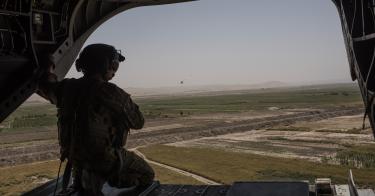After a period of relative quiescence, Afghanistan burst back into the headlines in August. Current and former administration officials signaled U.S. President Donald Trump was keen to withdraw all U.S. troops from Afghanistan before the 2020 election. The administration is now reportedly close to signing an interim peace agreement with the Taliban. There is growing concern, however, that in a fairly public rush for the exits, the Trump administration is both alienating U.S. allies in Afghanistan and vulnerable to signing a bad deal with a partner negotiating in bad faith.
President Trump has never been coy about his desire to end the “endless wars.” Last September his impatience with the stalemate in Afghanistan led him to appoint Zalmay Khalilzad as Special Representative for Afghanistan Reconciliation. Khalilzad was given a mandate to hasten a diplomatic resolution and pursue direct talks with the Taliban, which proved willing to reciprocate. Within just a few months, the two sides claimed to have reached agreement on 90 percent of outstanding issues.
The Taliban and the U.S. are reportedly now on the verge of signing an agreement covering America’s future military presence in the country and a Taliban commitment never to allow Afghan soil to be used for international terrorism. In theory, this would open the door to the elusive holy grail: direct negotiations between the Taliban and the Afghan government.
There are many good reasons to doubt the intentions of the Taliban and their benefactors in Pakistan. However, if the group is finally willing to negotiate directly with the Afghan government, there are good reasons to see what the peace process might produce. What is not strategically advisable is publicly signaling that a withdrawal of U.S. forces is necessary or imminent. It neither strengthens America’s hand in negotiations nor serves its national interests. And it betrays a misreading of the current situation in Afghanistan and America’s position there.
The Spurious Stalemate
Since 2017 U.S. military commanders have solemnly described the struggle against the Taliban as a battlefield “stalemate.” While the conflict isn’t high on the U.S. public’s priority list, many Americans, President Trump included, regard it with a sense of fatigue and frustration. Half of those surveyed by Pew now say the U.S. has “mostly failed,” with just over one-third believing it has “mostly succeeded.”
After 18 grueling years of conflict, it’s hard to inspire much optimism in a stalemate, but the dominant narrative about the conflict in Afghanistan appears increasingly divorced from reality. What if the stalemate in Afghanistan isn’t symbolic of strategic defeat but the sober landscape of victory?
Remember, a stalemate doesn’t imply parity. A U.S. report in October 2018 assessed the Afghan government controlled areas where 64 percent of the Afghan population lives, while the Taliban controlled areas where 11 percent live. The remaining 26 percent live in “contested” areas. In the entirety of the war, the Taliban has only twice seized a district capital, and in each case only for a few days. If the conflict is frozen in a stalemate, the Taliban is stuck with a losing hand. Indeed, it’s remarkable that, despite the U.S. reducing its presence by over 80 percent since 2014, the Taliban has failed to register substantial battlefield victories.
It’s also important to remember that a stalemated conflict is precisely where the U.S. found Afghanistan when it invaded in 2001. Only then, the roles were reversed. Backed by Pakistan, the Taliban, the victor of the Afghan civil war (1992-1996), was the governing power in Kabul. However, the United Front or “Northern Alliance” comprised of Afghan Uzbeks, Tajiks, Hazaras, and other opponents of the Taliban, were engaged in open military resistance with their own self-governing territory. When the U.S. invaded in 2001, it’s possible as much as one-quarter of Afghanistan’s population was living in territory controlled by the Northern Alliance.
What if, at least for the U.S., the endless war has already ended and it’s now falling mostly to the Afghans to win the peace? The U.S. military hasn’t been on the front line fighting the Taliban for years, a role assumed by the Afghan National Army. It is now relegated to the background, executing a critical train-and-assist mission and providing limited operational support against high-value targets.
An Evolving Mission
At what point does the U.S. mission cease being the Afghan War and become one of many counterterrorism train-and-assist missions run by the U.S. across the globe? Under the Pentagon’s Global Train and Equip program, the U.S. has over 250 projects aimed at improving counterterrorism capabilities of friendly countries. In 2019 the administration requested $11.2 billion for counterterrorism aid, including for programs in Bangladesh, Indonesia, Kenya, Tanzania, and Mali.
These programs aren’t politically contentious in the U.S. because, as far as the American public is concerned, their purpose is sound and the financial and human costs are reasonable. What if the U.S. mission in Afghanistan is already evolving from a war into another high-level train and assist mission? How do we distinguish between the two?
The cost, in terms of treasure and human life, is one indicator. Thankfully, for the U.S. costs in Afghanistan have fallen considerably. The U.S. military presence there has shrunk from over 100,000 soldiers in in 2010 to 14,000 today and is likely to decline further. This has been accompanied by a dramatic decline in the number of casualties. The year 2010 was the deadliest for U.S. forces in Afghanistan, with 496 U.S. fatalities. In 2016, 2017, and 2018, fatalities were 14, 17, and 15, respectively.
What about the financial cost? According to a May 2019 report from the Congressional Research Service, for 2020 “the Pentagon identified $18.6 billion in direct war costs in Afghanistan and $35.3 billion in ‘enduring theater requirements and related missions,’ though it is unclear how much of this latter figure is for Afghanistan versus other theaters.” Whatever the real figure, it’s down considerably from the roughly $120 billion the U.S. was spending annually at the height of the war. And there’s ample room for a further reduction as international partners are capable of assuming more of the burden.
A Way Forward
None of this is to suggest it’s time for the U.S. to declare victory and exit Afghanistan. Quite the opposite. It suggests that, with modest and gradually declining levels of support from the U.S., the Afghan government is capable of sustaining itself and preventing Afghan soil from ever being used to launch terrorist attacks again.
It also means that, as it pursues talks with the Taliban, the Trump administration must not misplay its own hand; a bad deal is still worse than no deal at all. If the costs continue to fall, and the narrative reflects ground realities, the American public will support a high-level train-and-assist mission in Afghanistan, just as they do in Mali and Kenya.
First, the administration must repeatedly underscore that U.S. troop levels will be dictated by conditions on the ground and not the political calendar. Second, the administration must do a better job coordinating and consulting with key regional partners like India, while mending ties with alienated allies in Kabul. The Afghan government has repeatedly vented its frustration with how Amb. Khalilzad has approached talks with the Taliban, insecure about being cut out of negotiations and understandably skeptical about the intentions of Pakistan and the Taliban.
Third, and perhaps most important, Washington must keep up the pressure on Pakistan. As one Afghan official recently suggested, peace in Afghanistan will remain elusive until “Pakistan’s generals stop believing the cost of peace is higher than the cost of war.” The Trump administration was right to raise the cost of war, suspending aid to Pakistan last year after years of double-dealing by Islamabad. Islamabad should be encouraged to use its leverage with the Taliban to advance talks with the Afghan government, but Pakistan has a long history of making cosmetic, short-term changes to appeal to the U.S., only to revert to form when America’s attention shifts elsewhere. The Trump administration must break that cycle.
Fourth, the administration should offer the Taliban a stark choice: enter good faith negotiations with Kabul now and have a say in the future of governance and U.S. involvement in the country, or walk away knowing the U.S. is capable of securing its interests and sustaining the Afghan government with a modest counterterrorism presence. The reality is, while the Taliban excel at not losing, they don’t have a realistic path to victory—just a bleak future of launching terrorist attacks against their own countrymen in an unwinnable war.
This piece originally appeared in The Diplomat




